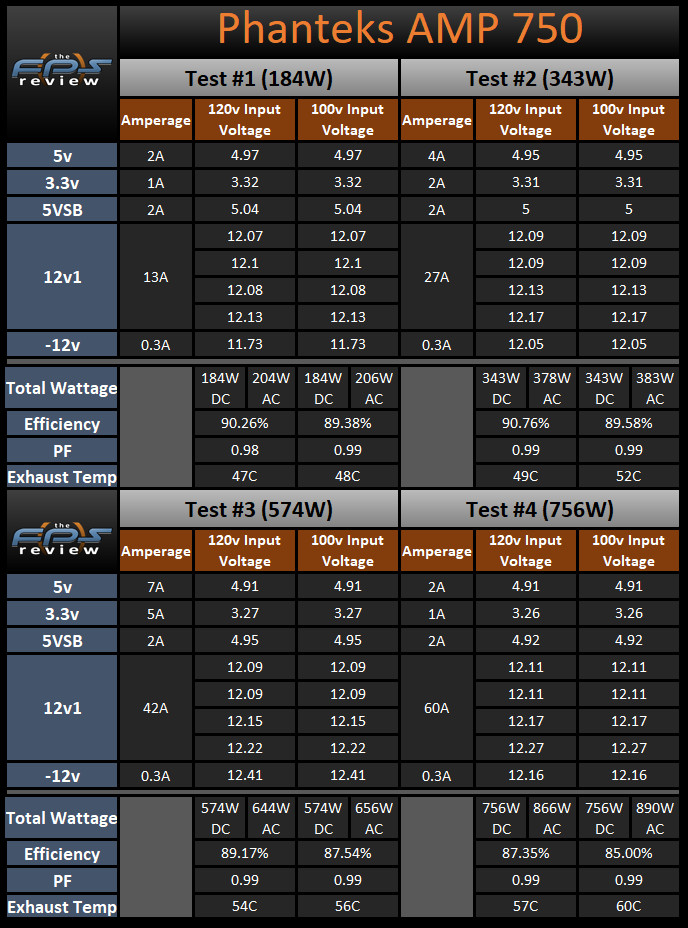Load Testing
For those of you that are curious as to some of the reasoning and equipment behind our PSU testing program here at TheFPSReview, we have put together an introduction for you. This program is based on what the author developed at [H]ardOCP and utilizes the equipment bequeathed to the author by Kyle Bennett. The testing we are conducting today is exactly as described in that document and start with our 120v, 100v, Torture, and 80 Plus Tests.
120v and 100v Load Testing Results

Test #1 is equal to approximately 25% of the rated capacity of the Phanteks AMP 750 at 45c. This makes Test #1 equal to 184W by loading the 12v rail to 13a, the 5v rail to 2a, the 3.3v rail to 1a, the +5vsb to 2a, and the -12v to 0.3a. The results of Test #1 show the main positive DC output rails starting above nominal except the 5v rail. The efficiency for this unit is starting off in excellent shape at a value of 90.26% at 120v AC input and 89.38% at 100v AC input. We see the exhaust temperature is 47C at 120v AC input and 48C at 100V AC input.
Test #2 is equal to approximately 50% of the rated capacity of the Phanteks AMP 750 at 45c. This makes Test #2 equal to 343W by loading the 12v rail to 21a, the 5v rail to 4a, the 3.3v rail to 2a, the +5vsb to 2a, and the -12v to 0.3a. Test #2 sees mixed results in the DC output voltages relative to what we saw with Test #1. The largest changes are up to a 0.05v increase on the 12v rail followed by a 0.02v drop on the 5v rail and a 0.01v drop on the 3.3v rail. The efficiency has moved up to 90.76% at 120v AC input and 89.58% at 100v AC input. We see an exhaust temperature of 49C at 120v AC input and 52C at 100V AC input.
Test #3 is equal to approximately 75% of the rated capacity of Phanteks AMP 750 at 45c. This makes Test #3 equal to 574W by loading the 12v rail to 42a, the 5v rail to 7a, the 3.3v rail to 5a, the +5vsb to 2a, and the -12v to 0.3a. Test #3 sees the 5v and 3.3v rails drop by 0.04v each. The 12v rail has increased by up to 0.05v. The efficiency in Test #3 moves down to 89.17% at 120v AC input and up to 87.54% at 100v AC input. We see an exhaust temperature of 54C at 120v AC input and 56C at 100V AC input.
Test #4 is equal to approximately 100% of the rated capacity of the Phanteks AMP 750 at 45c. This makes Test #4 equal to 756W by loading the 12v rail to 60a, the 5v rail to 2a, the 3.3v rail to 1a, the +5vsb to 2a, and the -12v to 0.3a. In the final regular test, we see the 12v rail move up by up to 0.05v. The minor rails, however, see a small decrease of 0.01v on the 3.3v rail or no change at all on the 5v rail. The efficiency has dropped as we see it come in at 87.35% at 120v AC input and 85.00% at 100v AC input. We see an exhaust temperature of 57C at 120v AC input and 60C at 100V AC input.
Torture Test

The Torture Test is equal to approximately 80% of the rated capacity of the Phanteks AMP 750 at 45C full load. This makes the Torture Test equal to 607W by loading the 12v rail to 44a, the 5v rail to 8a, the 3.3v rail to 5a, the +5vsb to 6a, and the -12v to 0.3a. At the end of the Torture Test, the AMP 750 is still doing well. The DC output voltages are generally in line with what we have been seeing in the 120v load tests. The efficiency is excellent as we see a value of 88.27.51% and the exhaust temperature is 60C.
Load Testing Summary
The Phanteks AMP 750 did a very good job in our initial load testing. When we look at the voltage regulation, we see that the AMP 750 had peak changes of 0.14v on the 12v rail, 0.06v on the 5v rail, and 0.06v on the 3.3v rail. These absolute values are easily in specification and very good overall. When we look at the efficiency values posted today, we see that the AMP 750 ranged from 87.35% to 90.76% efficient at 120v AC input and 85.00% to 89.58% efficient at 100v AC input. As this unit was not posted to the 80 Plus certification test database at the time of testing, we do not have the 80 Plus numbers for it in this review. However, given what we have seen here today it seems likely that this unit would have no problem making its claimed 80 Plus values. Lastly, the exhaust temperature peaked at 57C at 120v AC input, 60C at 100v AC input, and 60C during the Torture Test. With very good starting results in today’s testing, let’s move on to the Transient Load Tests.
